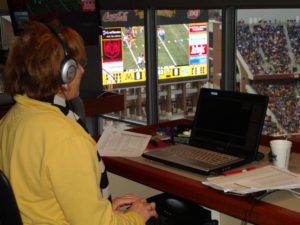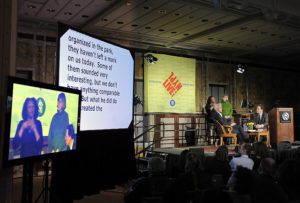According to a 2013/2014 Ducker Worldwide Court Reporting Industry Outlook Report sponsored by the National Court Reporters Association: “As the population continues to age and, with it, the incidence of hearing loss increases, demand for CART captioning in various public settings will likely continue to grow. In addition, continued pressure by the ADA and other groups will bring increased captioning demand to churches, medical facilities, and other arenas.”
- About 20% of adults in the United States – 48 million – report some degree of hearing loss.
- 60 percent of the people with hearing loss are either in the workforce or in educational settings.
- At age 65, one out of three people has hearing loss.
- The Americans with Disabilities Act mandates the elimination of discrimination against people with disabilities. Under the ADA, CART is recognized as an assistive technology that affords “effective communication access.”
- 80 percent of people who could benefit from hearing aids do not get them. One of the many reasons why may be the cost of hearing aids. CART captioners can stream English language text to devices that individuals already own such as laptops, tablets, and smartphones.
- A major public health issue, hearing loss is the third most common physical condition after arthritis and heart disease.
- Sudden, noise-induced hearing loss from gunfire and explosions is the number one disability caused by combat in current wars.
Q. What is CART?
A. The instant translation of all spoken words into English text using a steno machine, computer, and realtime software. The text appears on a computer monitor or other display [i.e., TV]. CART technology is primarily used by people who are deaf or hard of hearing or who are learning English as a Second Language. This service is offered for the benefit of an individual consumer or larger group in a variety of settings, such as these:
- Sports events

- Conferences and conventions
- Universities and colleges
- Closed captioning on TV and cable
- Classrooms (K-12 and post-secondary)
- Corporate and government functions
- Civic events, such as town council meetings
- Religious services
- Senior citizen meetings
- Personal appointments (i.e., doctor visits)
- Weddings or funerals
- Museums, theatrical or cultural presentations
Find out more about how Court Reporters, Captioners and CART providers meet the needs of millions of people globally in this brochure produced by the National Court Reporters Association. And if you’re confused about which service you need, this article explains the differences.
Most importantly, the next time you see a court reporter (on TV or in person) and/or view closed captioning, send him/her some appreciation for the tremendous skill, courage, and expertise required to provide this crucial service!
#courtreportingandcaptioningweek
Source: National Court Reporters Association (NCRA).
Top photo courtesy of Paradigm Reporting. Bottom photo courtesy of NCRA.
